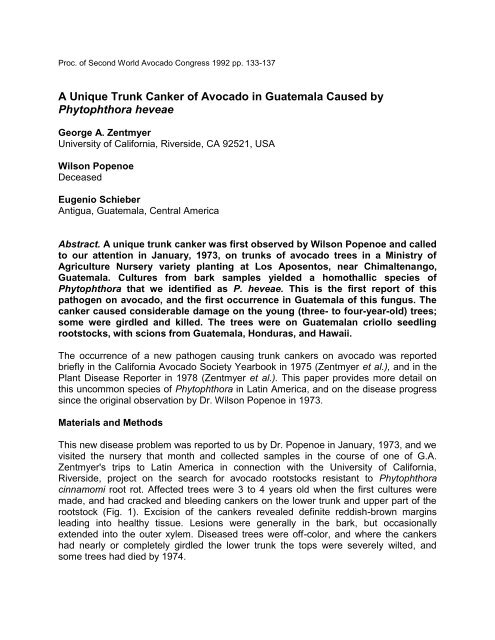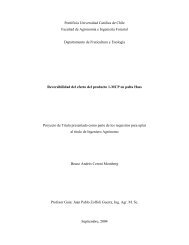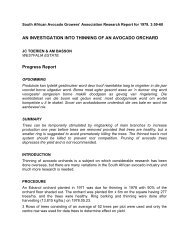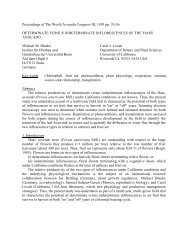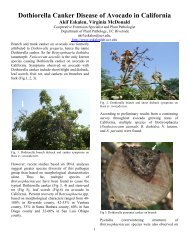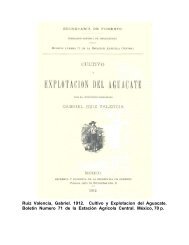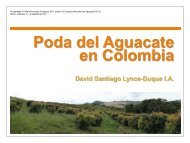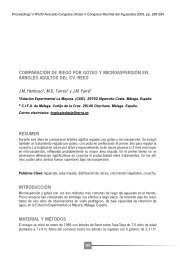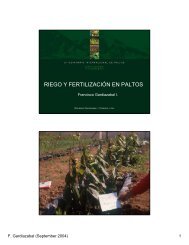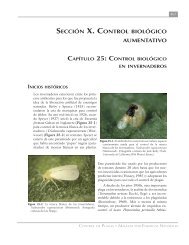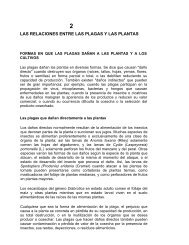A Unique Trunk Canker of Avocado in Guatemala Caused by ...
A Unique Trunk Canker of Avocado in Guatemala Caused by ...
A Unique Trunk Canker of Avocado in Guatemala Caused by ...
Create successful ePaper yourself
Turn your PDF publications into a flip-book with our unique Google optimized e-Paper software.
Proc. <strong>of</strong> Second World <strong>Avocado</strong> Congress 1992 pp. 133-137<br />
A <strong>Unique</strong> <strong>Trunk</strong> <strong>Canker</strong> <strong>of</strong> <strong>Avocado</strong> <strong>in</strong> <strong>Guatemala</strong> <strong>Caused</strong> <strong>by</strong><br />
Phytophthora heveae<br />
George A. Zentmyer<br />
University <strong>of</strong> California, Riverside, CA 92521, USA<br />
Wilson Popenoe<br />
Deceased<br />
Eugenio Schieber<br />
Antigua, <strong>Guatemala</strong>, Central America<br />
Abstract. A unique trunk canker was first observed <strong>by</strong> Wilson Popenoe and called<br />
to our attention <strong>in</strong> January, 1973, on trunks <strong>of</strong> avocado trees <strong>in</strong> a M<strong>in</strong>istry <strong>of</strong><br />
Agriculture Nursery variety plant<strong>in</strong>g at Los Aposentos, near Chimaltenango,<br />
<strong>Guatemala</strong>. Cultures from bark samples yielded a homothallic species <strong>of</strong><br />
Phytophthora that we identified as P. heveae. This is the first report <strong>of</strong> this<br />
pathogen on avocado, and the first occurrence <strong>in</strong> <strong>Guatemala</strong> <strong>of</strong> this fungus. The<br />
canker caused considerable damage on the young (three- to four-year-old) trees;<br />
some were girdled and killed. The trees were on <strong>Guatemala</strong>n criollo seedl<strong>in</strong>g<br />
rootstocks, with scions from <strong>Guatemala</strong>, Honduras, and Hawaii.<br />
The occurrence <strong>of</strong> a new pathogen caus<strong>in</strong>g trunk cankers on avocado was reported<br />
briefly <strong>in</strong> the California <strong>Avocado</strong> Society Yearbook <strong>in</strong> 1975 (Zentmyer et al.), and <strong>in</strong> the<br />
Plant Disease Reporter <strong>in</strong> 1978 (Zentmyer et al.). This paper provides more detail on<br />
this uncommon species <strong>of</strong> Phytophthora <strong>in</strong> Lat<strong>in</strong> America, and on the disease progress<br />
s<strong>in</strong>ce the orig<strong>in</strong>al observation <strong>by</strong> Dr. Wilson Popenoe <strong>in</strong> 1973.<br />
Materials and Methods<br />
This new disease problem was reported to us <strong>by</strong> Dr. Popenoe <strong>in</strong> January, 1973, and we<br />
visited the nursery that month and collected samples <strong>in</strong> the course <strong>of</strong> one <strong>of</strong> G.A.<br />
Zentmyer's trips to Lat<strong>in</strong> America <strong>in</strong> connection with the University <strong>of</strong> California,<br />
Riverside, project on the search for avocado rootstocks resistant to Phytophthora<br />
c<strong>in</strong>namomi root rot. Affected trees were 3 to 4 years old when the first cultures were<br />
made, and had cracked and bleed<strong>in</strong>g cankers on the lower trunk and upper part <strong>of</strong> the<br />
rootstock (Fig. 1). Excision <strong>of</strong> the cankers revealed def<strong>in</strong>ite reddish-brown marg<strong>in</strong>s<br />
lead<strong>in</strong>g <strong>in</strong>to healthy tissue. Lesions were generally <strong>in</strong> the bark, but occasionally<br />
extended <strong>in</strong>to the outer xylem. Diseased trees were <strong>of</strong>f-color, and where the cankers<br />
had nearly or completely girdled the lower trunk the tops were severely wilted, and<br />
some trees had died <strong>by</strong> 1974.
Isolations were made <strong>by</strong> the senior author us<strong>in</strong>g small pieces <strong>of</strong> bark from the active<br />
marg<strong>in</strong>s <strong>of</strong> the lesion on the lower trunks <strong>of</strong> the small trees. Bark pieces were plated on<br />
media selective for Phytophthora <strong>in</strong> an improvised hotel room laboratory <strong>in</strong> Antigua the<br />
day <strong>of</strong> collection. Isolations were made aga<strong>in</strong> from the same plant<strong>in</strong>g <strong>in</strong> 1974 and 1977.<br />
Figure 1. Typical canker caused <strong>by</strong> Phytophthora heveae on young avocado tree <strong>in</strong><br />
<strong>Guatemala</strong>. Photo <strong>by</strong> Schieber.<br />
Results<br />
An obvious species <strong>of</strong> Phytophthora grew readily from a high proportion <strong>of</strong> the bark<br />
pieces cultured with<strong>in</strong> two to three days. Cultures were exam<strong>in</strong>ed a few days later on<br />
my return to Riverside, California. This turned out to be a homothallic species <strong>of</strong><br />
Phytophthora that produced abundant oospores <strong>in</strong> a few days at 24C on V8 agar.
As we had previously isolated a homothallic species <strong>of</strong> Phytophthora from trunk cankers<br />
<strong>in</strong> southern California <strong>in</strong> the 1960's and identified this as P. citricola (Zentmyer et al.,<br />
1974), there was a good possibility that this was the same fungus. Further microscopic<br />
study revealed that the <strong>Guatemala</strong>n isolate was a different species <strong>of</strong> Phytophthora, P.<br />
heveae Thompson.<br />
Phytophthora heveae is dist<strong>in</strong>guished <strong>by</strong> the unique form <strong>of</strong> the antheridium and<br />
oogonium, with an elongate antheridium and a balloon-shaped oogonium. This is quite<br />
different from the antheridium and oogonium <strong>in</strong> P. citricola, and also P. cactorum, the<br />
other homothallic species that was reported on avocado many years ago. The<br />
antheridia are amphigynous, thus dist<strong>in</strong>ct from P. cactorum which has paragynous<br />
antheridia. Sporangia were formed readily on V8 agar and other agar media, and are<br />
somewhat irregular <strong>in</strong> shape, with the sporangiophore sometimes attached laterally.<br />
More details on the fungus mycelium, sporangia and oospores are given <strong>in</strong> our 1978<br />
paper (Zentmyer et al.).<br />
Waterhouse (1956) describes P. heveae as follows: "Range <strong>of</strong> sporangia 27-66 x 20.5-<br />
48 µm, average size <strong>of</strong> 400:45.9 29.62. Mean ratio <strong>of</strong> length to width = 1.55. Oogonia<br />
and oospores freely formed on potato dextrose agar media and also <strong>in</strong> water. Oogonia<br />
broadly funnel shaped with amphigynous antheridia. Oospores round, smooth, and thick<br />
walled, not always colored dist<strong>in</strong>ctly. Range <strong>of</strong> 200 oogonia = 17-32 µm, mean = 25.9,<br />
range <strong>of</strong> 250 oospores = 15-26.8 µm, mean = 21.46."<br />
Inoculations <strong>of</strong> stems <strong>of</strong> young avocado seedl<strong>in</strong>gs (cv. Topa Topa) with two<br />
<strong>Guatemala</strong>n isolates <strong>of</strong> P. heveae <strong>in</strong> the greenhouse resulted <strong>in</strong> rapid development <strong>of</strong><br />
lesions with growth similar to cankers formed <strong>by</strong> P. c<strong>in</strong>namomi (Fig. 2). <strong>Canker</strong>s<br />
produced <strong>by</strong> P. heveae averaged 6.2 cm <strong>in</strong> 8 days; P. c<strong>in</strong>namomi cankers averaged 4.7<br />
cm.<br />
The orig<strong>in</strong>al description <strong>of</strong> P. heveae was <strong>in</strong> 1929 <strong>by</strong> Thompson <strong>in</strong> Malaysia. He<br />
reported the fungus as parasitic on bark and fruit <strong>of</strong> Heveae brasiliensis (H.B.K.) Muell.<br />
P. heveae has been described on additional hosts s<strong>in</strong>ce 1929, <strong>in</strong>clud<strong>in</strong>g cacao<br />
(Theobroma cacao L.) <strong>in</strong> Malaysia, Brazil (Luz et al., 1989), and Mexico (Lozano-<br />
Trev<strong>in</strong>o and Romero-Cova, 1984); rhododendron <strong>in</strong> North Carol<strong>in</strong>a (D.M. Benson,<br />
personal communication), p<strong>in</strong>e soil <strong>in</strong> the southeastern United States (Campbell and<br />
Gallegly, 1965), Eucalyptus soil <strong>in</strong> Australia (Gerrettson-Cornell, 1976), a forest tree<br />
(Agathis australis) <strong>in</strong> New Zealand (Gadgil, 1974), and Brazil nut trees <strong>in</strong> Brazil<br />
(Albuquerque eta/., 1974). The fungus is a common pathogen on rubber <strong>in</strong> Malaysia.<br />
P. heveae is not a common pathogen <strong>in</strong> Lat<strong>in</strong> America; this is the first report on<br />
avocado, and the first report <strong>of</strong> the fungus on any host <strong>in</strong> <strong>Guatemala</strong>.<br />
The nursery <strong>in</strong> <strong>Guatemala</strong> was visited aga<strong>in</strong> <strong>in</strong> 1974 and 1977. At the time <strong>of</strong> the<br />
orig<strong>in</strong>al isolations there was considerable damage on the avocado trees; several trees<br />
were girdled and had died. When additional notes were taken <strong>in</strong> 1977, 30 percent <strong>of</strong> the<br />
223 trees <strong>in</strong> the nursery variety plant<strong>in</strong>gs had either been removed or were very
severely diseased. The trees <strong>in</strong> the plant<strong>in</strong>gs were all on local <strong>Guatemala</strong>n "criollo"<br />
seedl<strong>in</strong>g rootstocks, with scions from <strong>Guatemala</strong>, Honduras, and Hawaii <strong>in</strong>clud<strong>in</strong>g<br />
'Siqu<strong>in</strong>ala', 'Chocola 5', 'R<strong>in</strong>conada', 'Zamorano 10', and 'Haankuu Hawaii'. The plant<strong>in</strong>g<br />
did not make good growth overall, and was removed <strong>in</strong> the mid-1980's.<br />
This canker has not been observed on any other avocado trees <strong>in</strong> <strong>Guatemala</strong>, or on any<br />
other host <strong>in</strong> that country. To date this pathogen has not been found <strong>in</strong> California on<br />
avocado, nor reported from any other country on avocado. There are few records <strong>of</strong> the<br />
species <strong>in</strong> Lat<strong>in</strong> America, <strong>in</strong> Mexico and Brazil.<br />
Figure 2. Lesions caused on stems <strong>of</strong> Persea <strong>in</strong>dica <strong>by</strong> <strong>in</strong>oculation with P. c<strong>in</strong>namomi<br />
(left) and P. heveae culture from <strong>Guatemala</strong> (center and left).
Discussion<br />
The reason for this curious isolated occurrence <strong>of</strong> a new pathogen on the small nursery<br />
plant<strong>in</strong>g <strong>in</strong> Los Aposentos, <strong>Guatemala</strong>, is difficult to determ<strong>in</strong>e. At the time <strong>of</strong> our first<br />
visit there were a number <strong>of</strong> young nursery trees still <strong>in</strong> nursery rows prior to plant<strong>in</strong>g <strong>in</strong><br />
the field there or mov<strong>in</strong>g to other groves. None <strong>of</strong> these small trees showed any<br />
<strong>in</strong>dication <strong>of</strong> the canker. There were a number <strong>of</strong> young deciduous fruit trees <strong>in</strong> the<br />
nursery and <strong>in</strong> a small field plant<strong>in</strong>g adjacent to the avocado field plant<strong>in</strong>g, with no<br />
evidence <strong>of</strong> disease development. The cankers were primarily on the rootstock portion<br />
<strong>of</strong> the grafted trees, with lesions spread<strong>in</strong>g from the ground level upward, so the<br />
<strong>in</strong>fection must have come from the soil or from the orig<strong>in</strong>al seedl<strong>in</strong>gs.<br />
Literature Cited<br />
Albuquerque, F.C., M.L.R. Duarte, G.R. Manco, and H.M. Silva. 1974. [Leafblight <strong>of</strong><br />
Brazil nut (Bertholletia excelsa) caused <strong>by</strong> Phytophthora heveae.]. Requeima das<br />
folhas da castanheira do Para (Bertholletia excelsa) casuada por Phytophthora<br />
heveae. Pesqui. Agropecu. Bras., Ser. Agron. 9:101-105.<br />
Campbell, W.A. and M.E. Gallegly. 1965. Phytophthora heveae from eastern<br />
Tennessee and western North Carol<strong>in</strong>a. Plant Dis. Reptr. 49:233-234.<br />
Gadgil, P.D. 1974. Phytophthora heveae, a pathogen <strong>of</strong> kauri. N. Z. J. for Sci. 4:59-63.<br />
Gerrettson-Cornell, L 1976. Phytophthora heveae and P. boehmeriae <strong>in</strong> a Eucalyptus<br />
pilularis plantation <strong>in</strong> New South Wales. Austral. Plant Pathol. Soc. Newsl. 5:8-9.<br />
Lozano-Trev<strong>in</strong>o, Z.E. and S. Romero-Cova. 1984. Estudio taxonmico de aislamiento de<br />
Phytophthora patogenos de cacao. Agrociencia 56:175-182.<br />
Luz, E.D.M.H., S D.V.M. Silva, and DJ. Mitchell. 1989. Phytophthora heveae: outra<br />
especie causando podridao pardado cacaueirona Bahia. Fitopatologia Bras. 14:160<br />
(Abstr.).<br />
Thompson, A. 1929. Phytophthora species <strong>in</strong> Malaysia. Malaysian Agric. 17:55-100.<br />
Waterhouse, G.M. 1956. The Genus Phytophthora. Commonwealth Mycological<br />
Institute Misc. Publication 12, 120pp.<br />
Zentmyer, G.A., L. Jefferson, C.J. Hickman, and Y. Chang-Ho. 1974. Studies <strong>of</strong><br />
Phytophthora citricola, isolated from Persea americana. Mycologia 66:830-845.<br />
Zentmyer, G.A., LJ. Klure, and E.G. Pond. 1978. A new canker disease <strong>of</strong> avocado<br />
caused <strong>by</strong> Phytophthora heveae. PI. Dis. Reporter 62:918-922.<br />
Zentmyer, G.A., E. Schieber, and W. Popenoe. 1975. Phytophthora canker <strong>of</strong> avocado<br />
trees <strong>in</strong> <strong>Guatemala</strong>. Calif. <strong>Avocado</strong> Soc. Yrbk. 58:136-137.


